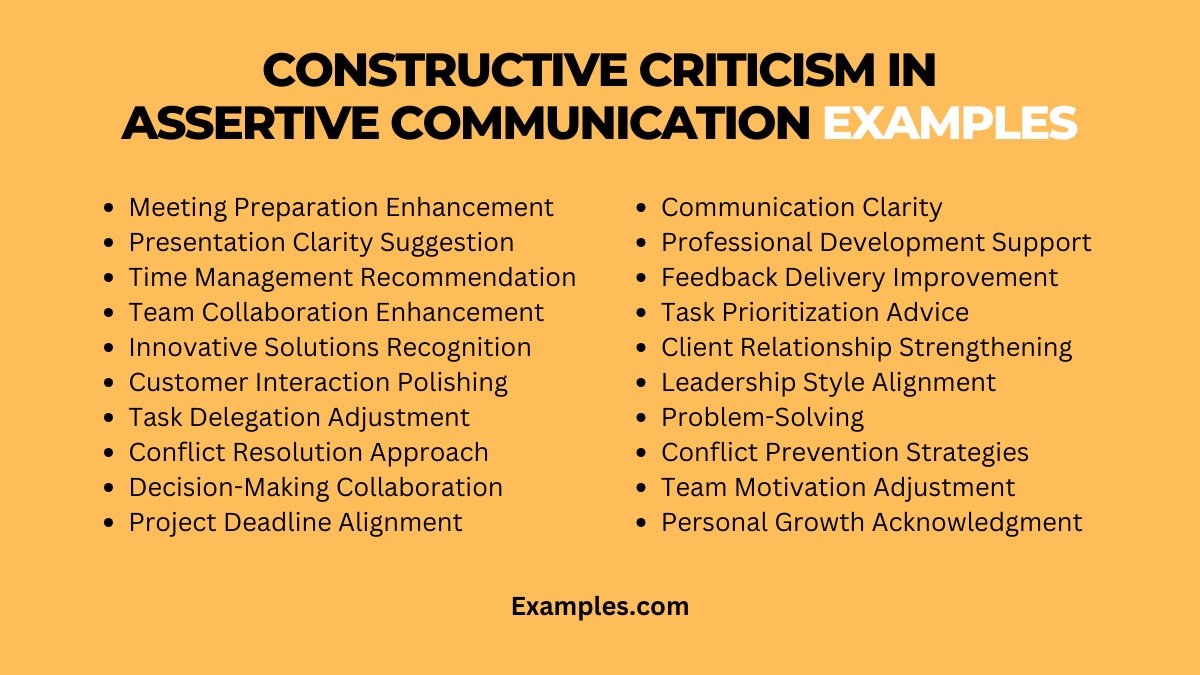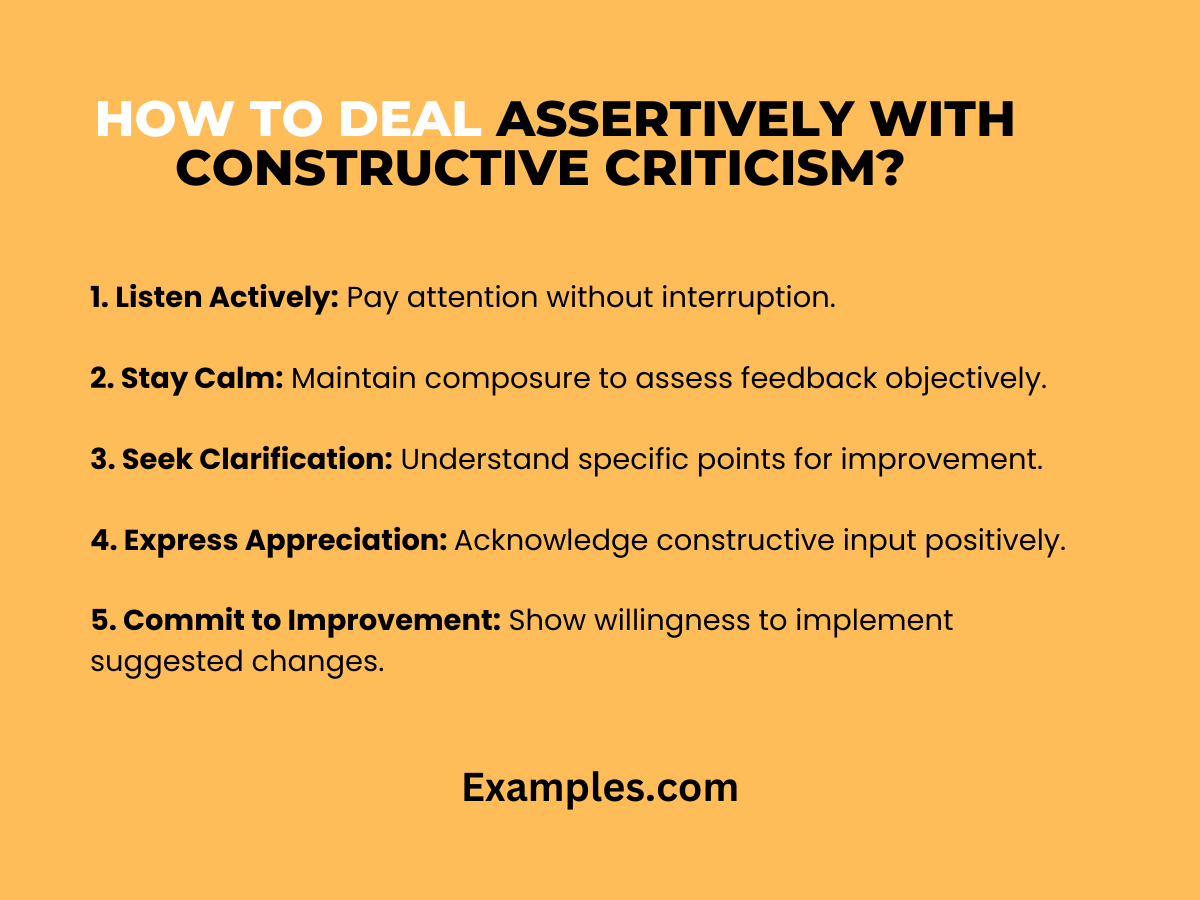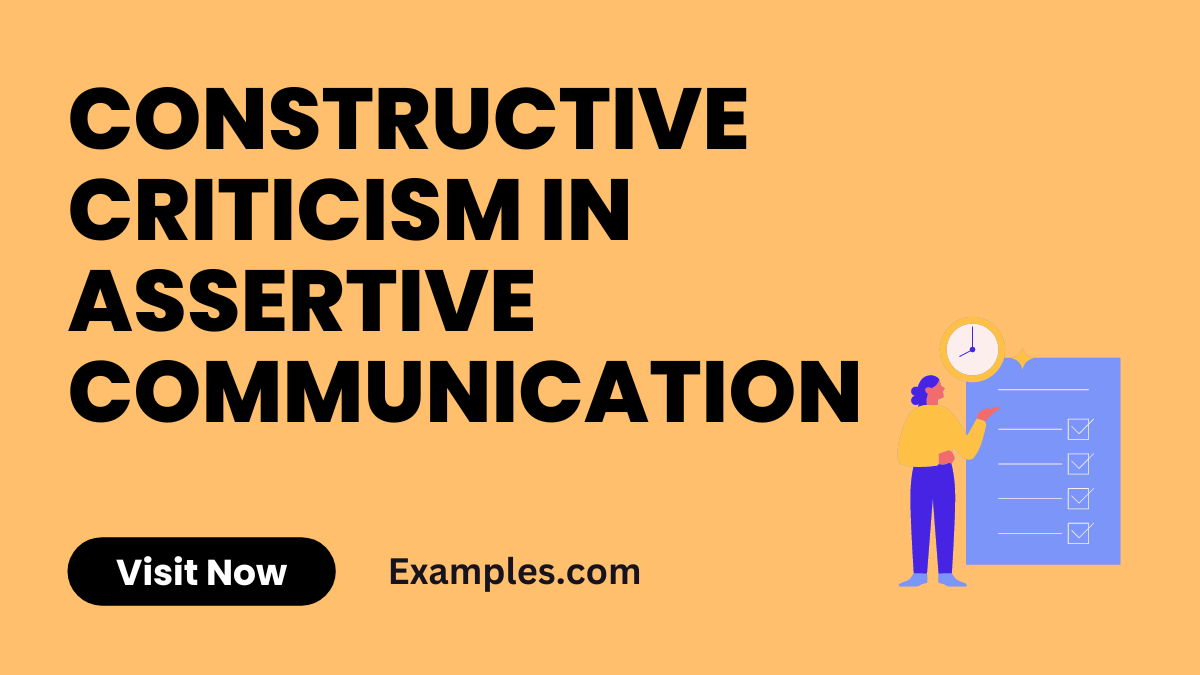19+ Constructive Criticism In Assertive Communication Examples
Unlock the power of constructive criticism in assertive communication. It involves providing feedback with a focus on improvement while maintaining a respectful tone. Dive into this guide to understand the essence of constructive criticism and enhance your communication skills.
What is Constructive Criticism In Assertive Communication?

Constructive criticism in assertive communication is a method of offering insightful feedback aimed at fostering improvement. It involves providing guidance and suggestions while maintaining a positive and respectful tone. The primary goal is to help individuals enhance their skills and performance. This approach encourages open dialogue and promotes a culture of continuous improvement.
20 Constructive Criticism In Assertive Communication Examples

Embrace assertiveness in providing constructive criticism. Use these examples to foster growth and improvement in various situations:
- Meeting Preparation Enhancement: Address a colleague with, “Your insights are valuable; consider preparing detailed points for more impactful discussions.”
- Presentation Clarity Suggestion: Improve presentations by stating, “Your content is great; let’s enhance clarity with concise slides for better audience engagement.”
- Time Management Recommendation: Encourage efficiency by saying, “Your work is commendable; consider prioritizing tasks for more effective time management.”
- Team Collaboration Enhancement: Foster teamwork with, “Your efforts are crucial; let’s ensure everyone’s input is actively considered for collaborative success.”
- Innovative Solutions Recognition: Boost creativity by affirming, “Your ideas are impressive; let’s explore innovative solutions to further enhance our projects.”
- Customer Interaction Polishing: Provide guidance with, “Your communication is good; let’s refine our customer interactions for an even more positive impact.”
- Task Delegation Adjustment: Guide assertively, stating, “Your delegation is appreciated; let’s adjust responsibilities for a balanced workload.”
- Conflict Resolution Approach: Encourage a constructive approach with, “Your efforts to resolve conflicts are essential; let’s ensure a balanced and respectful resolution.”
- Decision-Making Collaboration: Foster inclusive decisions by saying, “Your input is crucial; let’s ensure collaborative decision-making for better team alignment.”
- Project Deadline Alignment: Guide towards efficiency, stating, “Your commitment is evident; let’s align project deadlines to optimize our collective efforts.”
- Communication Clarity Recommendation: Enhance clarity in communication with, “Your messages are valuable; let’s ensure clearer communication for better understanding.”
- Professional Development Support: Encourage growth by affirming, “Your dedication is admirable; let’s support your professional development for long-term success.”
- Feedback Delivery Improvement: Guide in giving feedback with, “Your insights matter; let’s refine our feedback delivery for a more constructive impact.”
- Task Prioritization Advice: Provide guidance, stating, “Your multitasking skills are commendable; let’s prioritize tasks for optimal project efficiency.”
- Client Relationship Strengthening: Affirm client interactions with, “Your client rapport is excellent; let’s implement strategies for even stronger relationships.”
- Leadership Style Alignment: Guide assertively, saying, “Your leadership is impactful; let’s align our leadership styles for better team synergy.”
- Problem-Solving Approach Enhancement: Foster innovation with, “Your approach is good; let’s explore alternative problem-solving methods for more comprehensive solutions.”
- Conflict Prevention Strategies: Guide assertively, stating, “Your efforts are commendable; let’s implement proactive strategies to prevent conflicts before they escalate.”
- Team Motivation Adjustment: Encourage motivation with, “Your efforts are appreciated; let’s adjust motivational strategies for a more engaged team.”
- Personal Growth Acknowledgment: Affirm personal development, saying, “Your commitment is commendable; let’s support your personal growth journey within the team.”
Constructive Criticism In Assertive Communication Examples for Students
Guide students with assertive constructive criticism for effective growth:
1. Assignment Improvement Suggestion: Communicate, “Your effort is visible; let’s enhance your assignments with more detailed analysis for better grades.”
2. Class Participation Encouragement: Say, “Your contributions matter; consider expressing your unique perspectives during class discussions for a richer learning experience.”
3. Exam Preparation Strategy: Guide assertively, stating, “Your dedication is commendable; let’s refine your exam preparation strategy for improved performance.”
4. Time Management Advice: Encourage efficiency with, “Your workload is manageable; consider prioritizing tasks to balance academics and personal time effectively.”
5. Group Project Collaboration: Foster teamwork by affirming, “Your collaboration is essential; let’s ensure everyone’s input is valued for a successful group project.”
Constructive Criticism In Assertive Communication Examples for a Team
Lead teams effectively with assertive constructive criticism for enhanced collaboration:
1. Project Deadline Alignment: Communicate, “Your commitment is evident; let’s align project deadlines to optimize our collective efforts for successful project completion.”
2. Communication Clarity Recommendation: Enhance clarity in communication with, “Your messages are valuable; let’s ensure clearer communication for better understanding within the team.”
3. Task Prioritization Advice: Provide guidance, stating, “Your multitasking skills are commendable; let’s prioritize tasks for optimal project efficiency and success.”
4. Client Relationship Strengthening: Affirm client interactions with, “Your client rapport is excellent; let’s implement strategies for even stronger relationships and client satisfaction.”
5. Leadership Style Alignment: Guide assertively, saying, “Your leadership is impactful; let’s align our leadership styles for better team synergy and productivity.”
What are Benefits of Constructive Criticism In Assertive Communication?
- Promotes Growth: Encourages personal and professional development.
- Enhances Collaboration: Fosters effective teamwork and communication.
- Builds Resilience: Strengthens individuals to overcome challenges.
- Improves Performance: Guides towards optimal productivity and success.
- Strengthens Relationships: Builds trust and transparency within teams.
How to Deal Assertively with Constructive Criticism?

Dealing assertively with constructive criticism involves adopting a positive and proactive approach to feedback. Here are some strategies to handle constructive criticism assertively:
- Listen Actively: Pay close attention to the feedback without interrupting. Demonstrate that you are open to hearing different perspectives.
- Stay Calm: Maintain composure and manage your emotions. Avoid reacting defensively, and take a moment to process the feedback before responding.
- Express Gratitude: Acknowledge the feedback with gratitude, showing that you appreciate the input provided.
- Seek Clarification: If certain aspects of the criticism are unclear, ask for specific examples or details to gain a better understanding.
- Reflect on Feedback: Take time to reflect on the feedback received. Consider its validity and how it aligns with your goals and values.
- Respond Thoughtfully: Craft a response that is assertive, emphasizing your commitment to improvement. Avoid being confrontational or dismissive.
- Propose Solutions: If applicable, suggest proactive solutions to address the highlighted areas for improvement. This demonstrates your willingness to take initiative.
- Learn and Grow: View constructive criticism as an opportunity for personal and professional growth. Use the feedback as a tool to enhance your skills and performance.
- Establish Boundaries: If the criticism becomes overly negative or personal, assertively communicate your boundaries and focus on constructive aspects.
- Follow Up: Keep the lines of communication open. If you implement changes based on the feedback, provide updates on your progress. This reinforces your commitment to improvement.
Tips for Effective Constructive Criticism In Assertive Communications
Providing effective constructive criticism in assertive communications involves a careful balance of clarity, empathy, and respect. Here are some tips to ensure the constructive criticism is delivered assertively:
- Be Specific and Clear: Clearly identify the behavior or issue you are addressing. Use concrete examples to illustrate your points, making it easier for the recipient to understand.
- Focus on Behavior, Not Personality: Frame your criticism around specific behaviors rather than making generalizations about the person. This helps prevent the recipient from feeling attacked.
- Use “I” Statements: Express your observations and feelings using “I” statements to convey your perspective without sounding accusatory. For example, say “I noticed” instead of “You always.”
- Choose the Right Time and Place: Find an appropriate and private setting to discuss the feedback. Timing matters, and selecting the right moment can enhance receptiveness.
- Balance Positives with Negatives: Acknowledge the individual’s strengths or positive aspects before delving into areas that need improvement. This helps maintain a balanced perspective.
- Offer Constructive Solutions: Instead of just pointing out problems, suggest potential solutions. Collaborate on finding ways to address the issues, promoting a sense of partnership.
- Be Empathetic: Acknowledge the impact your feedback may have on the individual. Show understanding and empathy, recognizing that receiving criticism can be challenging.
- Encourage Two-Way Communication: Create an environment where the individual feels comfortable sharing their perspective. Encourage questions and clarification to ensure mutual understanding.
- Stay Calm and Neutral: Maintain a calm and composed demeanor. Avoid becoming emotional or aggressive, as it may hinder effective communication.
- Use Nonverbal Cues: Pay attention to your body language and tone of voice. Nonverbal cues can significantly impact the way your message is received.
- Offer Feedback Regularly: Establish a culture of ongoing feedback rather than saving it for specific occasions. Regular check-ins can make constructive criticism feel more natural and less intimidating.
- Follow Up: After providing feedback, follow up to check on progress. This demonstrates your commitment to the individual’s growth and development.
Incorporating constructive criticism enhances Effective Communication in Workplace, fostering growth and collaboration. Embracing feedback positively contributes to personal and professional development. By navigating assertive communication, individuals cultivate resilience and strengthen relationships. This guide empowers you to apply constructive criticism effectively, promoting a culture of continuous improvement and open dialogue in your communication journey.



